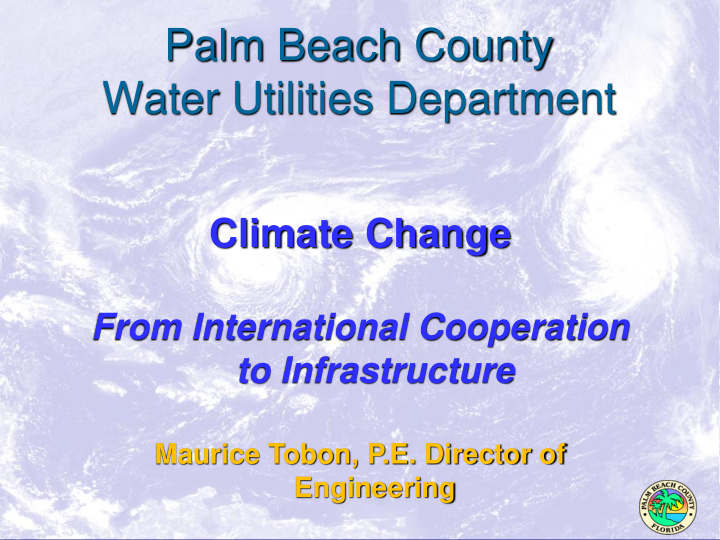



Palm Beach County Water Utilities Department Climate Change From International Cooperation to Infrastructure Maurice Tobon, P.E. Director of Engineering
Outline Palm Beach County Utilities Background National and International Cooperation Anticipated Climate Change Impacts Adaptation Issues and Challenges Future
Utility Background Florida’s 3 rd largest water and wastewater utility 490,000 residents served 598 employees $115 million annual operating budget Recognized as an industry leader
Major Facilities 5 Water Treatment Plants with total capacity of 113 mgd Over 100 surficial wells, 8 Floridan wells 2 Wastewater Treatment Plants with total capacity of 59 mgd 22 mgd Reclaimed Water Facility 4 mgd Wetland Treatment capacity 869 WW Pump Stations 4
Local and National Cooperation Water Research Foundation Water Industry Climate Change Research Needs Workshop January 7-9, 2008 Develop a Dynamic Decision Support System (D2S2) for Water Supply Planning in the Lower East Coast of Florida 2010 (WEAP Model) Incorporating Climate Change Information in Water Utility Planning: A Collaborative, Decision Analytic Approach 2010 Water Utilities and Climate Change: A Research Workshop on Effective System Adaptation 2012
Local and National Cooperation Southeast Florida Climate Change Compact, Built Environment Work Group Florida Water Climate Alliance Institute of Sustainable Communities Climate Change Academy, Philadelphia 2013.
USAID, Waterlinks Partnership on Building Climate Resilient Water Service Providers Manila, Philippines Manila expanding, main water source in question, drought/excess MWSS with Maynilad and Manila Water seek innovations and practical knowledge on furthering capacity WaterLinks and USAID ECO-Asia support to: • Increase awareness and/or understanding of climate sciences and variability • Introduce and test planning tools and processes to MWSS, Maynilad and Manila Water that integrate climate change- related factors Established linkage with peers – U.S. Palm Beach County Water Utilities Department and National Center for Atmospheric Research (NCAR)
Partnership Framework Resource Recipient Climate science, climate variability, Partners Partners WEAP, XLRM, climate-proofing Palm Beach MWSS USAID ECO-Asia and NCAR Manila Water WaterLinks facilitate/fund Maynilad Water Coordinate and share information Other partners PAGASA National Power Corporation PAWD
Outputs and Outcome Trial model runs for Metro Manila’s water system (Angat Dam) Confirmed need to collect useful and analyze climate-related data • Better linkages with PAGASA Increased understanding of CC impacts to operations (inc climate- proofing efforts) Opportunity for improved analysis • Operations planning for dams • Water quality in the dams • Tributaries flow in watershed
Anticipates Climate Change Impacts Palm Beach County Water Utilities (PBCWUD)will be most affected by these climate change impacts: Sea Level Rise Salt Intrusion- easterly utilities Flooding Tropical Storm Activity Storm Frequency increasing ?? Storm Intensity Precipitation Patterns Rainfall return periods decreasing, extended dry periods Inflow & Infiltration Future Demand Forecast Water demands increase f(temp) Population Growth/Environmental Migration
How has PBCWUD adapted ? Diversification of Water Resources Climate Resilience Salt Water Intrusion/Inland Supply Reducing Infiltration/Inflow Facility Planning (Noah’s Ark)
Diverse Water Resources ASR (Aquifer Storage and Recovery) C-51 Reservoir (surface water storage) Wastewater Reuse (supplement local groundwater, multiple use water)
Climate Resilience Hardening of Facilities Continued Operations Post Disaster Recovery
Hurricane Hardening We are hardening utility facilities to reduce potential damage during a Hurricane $ 1.2 million for Hurricane Hardening in FY 2008 and 2009, Improvements made at Water Treatment Plant #3, Southern Region Operations Center, Southern Region Water Reclamation Facility and 2 Pump Stations Provisions for Category 4-5 Storms Design-build contract for Emergency Rebuilding
Hurricane Hardening Treatment Facilities
Lift Station Plan Rotate portable generators among several lift stations Provide skid mounted generators at master or high flow lift stations Skid Mounted Generator at Lift Station 222 generators available
Central Monitoring Facility (aka Hurricane Bunker) Will contain dispatch services, SCADA and monitoring Designed to withstand a Cat 5 Hurricane Cost $ 1.9 Million
Disaster Recovery Plan Disaster recovery through design build contract with CDM Smith. For reconstruction of damaged facilities. Service Level for Category 1-3 Hurricane Maintain continuous water pressure No system-wide boil water order Maintain wastewater treatment capability Minimize sewage overflows due to loss of power Service Level for Category 4-5 Hurricane Maintain water in storage tanks Provide water for water tank trucks Supply water to emergency distribution centers Isolate plants or key distribution lines Restart/ maintain water plant operation Restart/ maintain regional wastewater plants
Salt Water Intrusion/Inland Supply Salt water intrusion will limit water supplies for the coastal utilities. Maintain excess water treatment capacity to allow supply of coastal communities with potable water.
3 foot SLR North/Central County Reference: Southeast Florida Regional Climate Change Compact Inundation Mapping and Vulnerability Assessment Work Group. August 2012. Analysis of the Vulnerability of Southeast Florida to Sea Level Rise.
Excess WTP Capacity
Water Interconnects
Facility Planning Have a plan to address rapid increase in population. – Future Northern Region WTP, site plan approved .
Inventory of Critical Equipment Elevations Elevation Water Facility (ft) WTP#9 FIN. FL. EL. (88) 16.50 Strainers 26.50 HSP/ Feed/ Concentrate Pump 18.83 Cartridge Filter 19.83 Transfer Pump Clearwell 28.66 Bulk Chemical Storage Wall 17.00 Ammonia Meter 21.00 Membrane Building FL. 16.50 Master WW Pump Station 16.34 Chlorine Building EL. 15.88
Issues and Challenges Including climate impacts into CIP planning Complexity of understanding climate models Access to downscaled climate data Funding of climate resilience projects Political will and commitment
Future Inventory of critical facility and equipment elevations and flood risk Fund Phase 2 of climate resilience projects Cooperate and maintain involvement with local Cities and Counties on Climate Adaptation Mentoring of Utilities overseas on climate adaptation and disaster risk reduction Build a more stainable climate resilient Water Utility
Recommend
More recommend